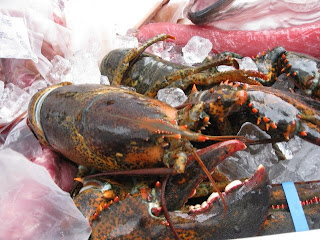 Occasional gratuitous bunny photos aside, I intended this blog to be about local economies, green crafting, and my attempts to live creatively and in a way which damages the planet as little as possible.
Occasional gratuitous bunny photos aside, I intended this blog to be about local economies, green crafting, and my attempts to live creatively and in a way which damages the planet as little as possible.But sometimes life gets in the way. Or, specifically, life-saving gets in the way. Even more specifically, bunny-life saving.
It's been a week and a half since my house rabbit Yogi came down with severe head tilt. Head tilt--more formally known as torticollus--happens when something damages a rabbit's sense of equilibrium, causing him or her to twist its neck in an effort stop its dizziness. Sometimes it's caused by an ear infection, sometimes by a protozoan, sometimes by a stroke, sometimes by cancer. Unless there's some visible discharge in the ear to culture, it's hard to know the cause and, therefore, the treatment. It's a life-threatening disease. And if the rabbit survives, it's likely to be permanently disabled.
 For now, Yogi's head is almost upside down. He can't walk or even lie upright unless he has firm support on his sides. The right side of his face drags on the ground, and he has ulcerated his cornea. When he tries to move, he spins in place as if he's on a super high speed rotisserie. It's frightening for both of us.
For now, Yogi's head is almost upside down. He can't walk or even lie upright unless he has firm support on his sides. The right side of his face drags on the ground, and he has ulcerated his cornea. When he tries to move, he spins in place as if he's on a super high speed rotisserie. It's frightening for both of us.I'm giving Yogi antibiotics, anti-protozoan, anti-nausea and anti-inflammatory drugs, eye drops, eye ointment, syringe-feeding him water and something called Critical Care, plus hand-feeding him as much hay and green vegetables as he will eat. The whole routine takes at least five hours a day, not including the trips we've taken to four different vets.
The good news is that he doesn't seem to be in pain, that he likes the taste of his medicines, that he's more affectionate than usual (he's given me more bunny kisses in the last week than in the previous five years), and that even if he ends up with a permanently tilted head, he might still be a happy rabbit for a good many more years. The bad news is that I'm exhausted from middle of the night feedings and butt-cleanings, that I'm spending my summer's earnings on vet bills, that there are no guarantees, and that I don't have enough time in the day to properly care for him and keep up with my soapmaking business, much less blog regularly.
But I did want anyone reading this to know that my blog isn't dead. It's just taken a temporary back seat to bunny slavery.
Time to give the little guy some head rubs and clover. But first, a 20-second video of some bunnies having a blast with a slinky. Rabbits are such clowns. How can you not love them?

























